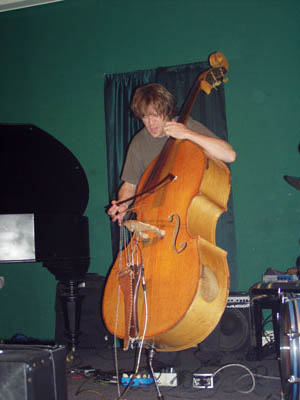Donnerstag, 19 Februar, 2004 - 22:00
Chris Dahlgren: Harmonic Cloud
biegungen21:
Chris Dahlgren
Harmonic Cloud No. 4 for four Double Basses
featuring:
Matthias Bauer (D)
Chris Dahlgren (USA)
Gerold Gensler (D)
Derek Shirley (CAN)
Chris Dahlgren
NOTES on the HARMONIC CLOUD COMPOSITIONAL SYSTEM:
META-FORM
This compositional system grows out of my experiments with sustained-tone, rational interval based compositions in the early 1990s via multi-track recording with double basses. There was never any written score. To date, ?Harmonic Cloud? has been exercised primarily in the
instrumental context of multiple double basses. This minute that comes to me over the past decillions, There is no better than it and now. However, this does not dissuade me from recognizing the systemic nature of this body of work post facto, and its potential application for any
sustained harmonic source. The quality of any composition in this system will be suspended, floating, temporal and non-linear, as its namesake. Hearing a composition in this system could be analogous to watching cloud formations from the window of a plane as you pass through them. The fundamental requirements of the ?Harmonic Cloud? system are that all parts must be harmonic and able to be precisely
controlled as such. They must be able to be continuously sustained for the prescribed duration of time. This is easily achieved with strings, organs and synthesizers, and also possible on wind and brass instruments with circular breathing and/ or tandem players of the same instrument.
HARMONIC CLOUD no. 4 for FOUR DOUBLE BASSES
MACRO-FORM
Harmonic Cloud no. 4 for Four Double Basses? is a composition of variable length. I believe a leaf of grass is no less than the journey-work of the stars,
Bar markings ?1?,?2?, etc. refer to a consistent and relative measurement of time, rather than to a specific one. The macro-form is based on a succession of four fundamental pitches descending in fourths: ?G?,?D?,?A? and ?E?- the open strings of the double bass. Most pitches are stationary,
meaning that they do not ?slide?. Stationary pitches are all pure (rational) intervals in relationship to the fundamental pitch, in this case 2, 3, 5, 7, 9 and 11. The reason for this is that the harmonic ?beats? arising from frequency difference tones (initiated by ?sliding? parts) will be more clearly defined in a pure-interval context. In addition, as the dynamic range specified is F to FF, pure intervals allow for a more powerful ensemble sound from the limited acoustic resources of a quartet of double basses.
In addition, it is suggested that the basses be tuned down to approximately ?A-334? (about a quarter-step flat) to facilitate an increase in volume. Outward and outward and for ever outward. Extremely precise tuning of instruments is required.
STRUCTURE-FORM
Structure-form for ?Harmonic Cloud no. 4 for Four Double Basses? is defined in an individual performance context. Actual performance length is to be determined by the performers with respect to the prescribed relative timings. Also, there is a great deal flexibility for performers to
determine the content of the sliding-parts ad lib, as only lowest and highest pitch limits are defined. Economy of movement and restraint in the sliding parts is essential to a successful realization of any ?Harmonic Cloud. Continue your annotations, continue your questionings. These
sliding-parts must be able shift pitch extremely slowly and evenly. To facilitate this I have modified and adapted wooden door handles to be held between the middle fingers of the left hand by performers of these
parts. All bowing is full-length and never coordinated between players, except that players generally attempt to make bow changes at different points. The included score for ?Harmonic Cloud no. 4 for Four Double Basses? was generated post facto, based on a multi-track version I
recorded in 7/01, and was performed at Wesleyan on 3/27/03. This composition is dedicated to the American composer Alvin Lucier, whose work illuminates worlds of rhythm within harmony.
As part of the series biegungen im ausland
